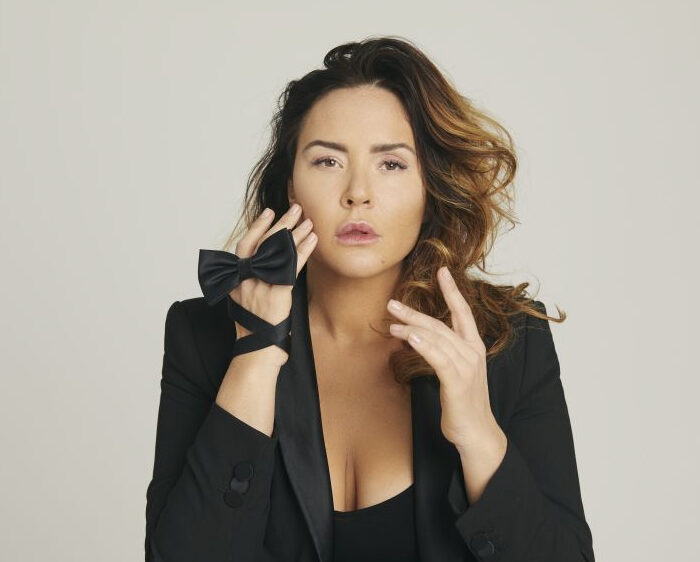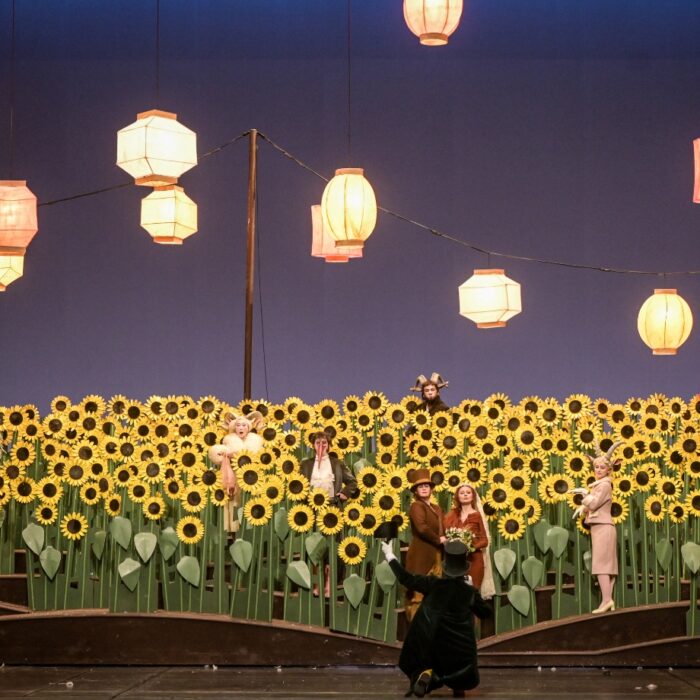
Opera Grand Rapids 2020 Review: Scalia / Ginsburg
Jennifer Zetlan & Company Illuminate Gorgeous Opera About Connecting Humanity Through Its Differences
By David SalazarDespite closing down in an effort to curtail the spread of COVID-19 around the world, many opera companies are still finding creative ways of reaching their respective audiences in the hopes of giving them some measure of relief. Moreover, these efforts are a reminder that despite these trying times, there is hope of an eventual return to normalcy and that when it comes, there will be more music and opera to look forward to.
Opera Grand Rapids is one of those companies that endeavored to presenting its recent production of “Scalia / Ginsburg” to audiences. The one-hour chamber opera by Derrick Wang is a fantastic gem of a piece that takes a look at the titular judges and their opposite viewpoints. But in doing so, the opera does what great works of art do – it tells us something far deeper and richer about human nature.
The work opens on Scalia lamenting the great flaw of the American system. “This court’s so changeable,” as if it’s never, ever known the law.” The suddenly a self-proclaimed Commentator shows up to tell Scalia that he is to be put on trial for his constant dissenting views. He is to undergo three different trials in a room where no man can enter, when suddenly Ruth Bader Ginsburg shows up stunning everyone.
The Commentator questions how she could possibly enter, to which she rebuffs that she’s a woman and that the rule of no man entering didn’t apply to her. From there, we learn of the two Supreme Court justices’ different views on the court, their pasts, and eventually their common bond as friends when at the end of the opera, they recognize themselves as one voice. “We are different” they add, though this entire passage is a duet that brings their voices together while they each highlight their uniqueness and views. This musical passage is the moment where the opera transcends of law and constitutional to speak directly to the beauty of human difference as its unifying force.
By mythologizing these two iconic figures in this manner, the opera reminds us how even those with the most divergent points of view can be truly close friends.
A Deeper Search
It is no secret that both Supreme Court Justices were / are lovers of the art form and it was this passion that connected them. So on a superficial level, this opera also comments opera as an inclusive art for many.
But “Scalia / Ginsburg” also takes its time to comment on the artform itself. Opera is undergoing a unique transitional period where its very identity is constantly under question. What is opera? What makes for great opera? How do you connect audiences with opera? All of these questions are full of radically different viewpoints with many seeking out a rather progressive mindset undoubtedly in line with Ginsburg while others are staunchly conservative like Scalia in this manner. Wang’s opera comments on this rather directly through its music.
In searching for a distinct language for this opera, Wang does not shy away from looking at the masters of the past and quoting them openly, weaving their distinct melodies together in unique, comic, and truly emotional ways. Scalia’s opening aria is Handelian in nature though it brings in certain quotations from “The first Noel.” Meanwhile, the Commentator openly quotes from Mozart’s operas and has a leitmotif right from the trial scene in Aida; when he faults women for change, we hear a snippet of the “Così fan tutte” theme. Later Scalia openly uses the opening of “Mi chiamano Mimí” in reference to how his friends call him “Nino,” but that the judge will call him “Justice Scalia” on the line in which the Puccini heroine confirms her name as “Lucia (the end of that aria also features a bit of play with the end of the Puccini aria from “La Bohème” with a quick witted close for Scalia). To a certain extent, the early portions of the opera seem rather indebted and almost dependent on these operatic masters to build up its musical soundscape. So many notable melodies fly by that you might get caught in their tangled web trying to keep up with the references; it feels a bit exhaustive even.
But then Ginsburg shows up and throws everything into whack. As the progressive judge, her music, while undeniably tied to previous musical masters, seems to find a unique voice of its own. Her opening aria is a bel canto piece with coloratura and the bit, but it’s both familiar and unfamiliar. At one point, she launches into a full-on jazz theme, a commentary that opens up the discussion on what kind of music can be included in an opera. But when she narrates her story and how she and society overcame the limits of male dominance on women and their roles, the aria is undeniably Mozartian in style and melodic invention, even taking on the full structure of one of his arias from an opera seria like “Idomeneo.” Its structural rigidity harkens back to older operatic style.
But it is at this point that the opera starts to find its own voice and the references to major operatic arias start to fade away, taking on new life. Scalia’s aria in which he narrates his father’s journey and why they have led to him being such a stickler for the rules is a Puccini-esque passage that even quotes “Nessun Dorma” at the start before evolving into something else completely, building and building like that famed aria, but resolved elsewhere.
Later, Scalia and Ginsburg find themselves in a lyrical duet of distinct and unique beauty; it contrasts greatly with the first duet they managed together, which contrasted “Sempre libera” with “Aprite, presto, aprite” quite splendidly. When the opera closes on a trio that also puts together three famed operatic passages, it also evolves into its own musical idea without necessarily shedding the inspiration on which it was built.
It is a truly mesmerizing and philosophical exploration not only of its subjects, but also of the opera in its own way.
True Artists
It’s also a blast to watch. For those that might be a bit overwhelmed by the legalese that gets thrown around, Wang, who also wrote the libretto, finds a way to pack the opera with a lot of humor. The libretto is often written with rhyming couplets that are not only clever, but also expansive in their wordplay. This is a libretto that was very carefully and intelligently crafted so as to really touch a breadth of audiences of all kinds of life; like its music, its themes, its story, it is the very definition of inclusive.
Cara Consilvio’s production, based on what was seen on the live stream, is rather simple with few props flanked by two large screens that project different images throughout the show. The cameras didn’t really capture it fully, but from the looks of it, it seemed rather uninstructive to the proceedings.
Over the recording, Emily Jarrell Urbanek led an organized musical ensemble that performed Wang’s music with great clarity; that you could pick up the tiny details of the score and ultimately sum them up into a bigger picture is undeniably a demonstration of brilliant success from the musical team.
Then there were the three soloists carrying us through the story. As Scalia, tenor Peter Scott Drackley struck a firm and unyielding figure, his singing similarly supported and potent. The opera makes pretty firm demands on his upper range and he handled every ascent quite beautifully, all the high notes resounding on the stream with a stable and supported squillo. Over a recording, the imperfections of singing come through with greater clarity than they do in the hall. But Drackley’s voice sounded rather clean in the stream. The same could be said for his diction which was spotless.
Ditto for the other two artists. As the Commentator, Michael Colman provided a firm bass-baritone with some fantastic low notes at the end of his aria as he tells Scalia that he will go down in the trial. He also had a few pattering sections in his first aria which were deftly pulled off.
It was actually quite interesting to see how the two men seemed to mirror one another visually throughout, both seemingly bastions of a certain order that was upended by the third figure in the triangle.
That, of course, would be Jennifer Zetlan’s Ruth Bader Ginsburg. In many ways, Zetlan is set up to be the star of the show. Her music is far more expansive in range and style than either of the two men and, as portrayed, her Ginsburg is far more colorful and expressive. She danced around during her first aria, even getting the men to join her as backup. She swiveled around in a seat as the Commentator tried to turn her out of the court room. She smiled where the other two were rather firm in their expressions. And in the opera’s climax, she is the heroine that brings it all together. Through it all, Zetlan managed to provide a portrait of a fun-loving but powerful woman, her voice full of incredible flexibility and range. She hit her highs with tremendous stability; she managed coloratura runs with utmost virtuosity; and even her few lows were robust and firm.
While this opportunity was only available via live stream on this occasion, it served as a reminder that in this moment of difficulty there are still opportunities to connect with one another. On both a textual and even metatextual level, this opera has accomplished that goal.
And in looking to the future, this is the kind of opera that should be everywhere. It provides the perfect template on which to build a conversation of how opera can evolve not by abandoning its past, but by working with it to build on it.


